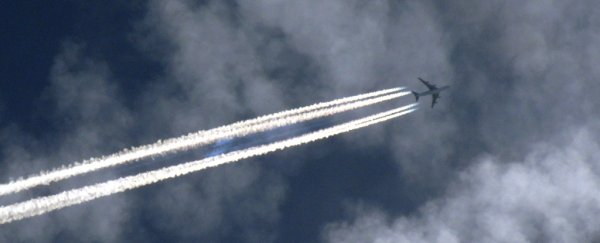Etched across the sky, long white lines reveal the high-altitude paths airplanes take to their destinations. But that's not all these vapour trails signify.
Most of the concern about air travel's environmental impact focuses on aviation's gigantic carbon footprint, but new research serves as an alarming reminder of how harmful airplane contrails themselves are.
Not to be confused with the erroneous conspiracy theory of chemtrails, contrails (aka condensation trails) are very real, and they're very impactful in terms of global warming processes.
When airplanes fly through the sky, moisture from their jet exhaust freezes into ice crystals high in the atmosphere. Depending on the atmospheric conditions, these clouds of ice crystals – known as contrail cirrus – can persist for minutes or hours before dispersing.
Just because these icy vapour clouds are cold, though, doesn't mean they're cooling – in fact, their effect is quite the opposite.
A study in 2011 calculated that the heat-trapping potential of contrail cirrus is actually greater than that of carbon emissions produced by airplanes, due to the way contrail clouds warm the planet through a process called radiative forcing.
Now, one of those researchers, atmospheric physicist Ulrike Burkhardt from the German Aerospace Centre, is back with a new study examining how this phenomenon might play out in the future.
The results are not promising. New modelling by Burkhardt and co-author Lisa Bock suggests that radiative forcing effects attributable to airplane contrails will triple from 2006 levels by the year 2050, due to increases in air traffic volume, as well as a slight shift in air traffic towards higher altitudes.
It's a disturbing outlook, given most of the world's efforts to combat aviation's environmental impacts are squarely addressed at limiting CO2 emissions, such as the CORSIA scheme.
"Lots of people talk about the need to stop air traffic increasing all the time, but this [contrail cirrus] is not taken that seriously," Burkhardt told New Scientist.
"That's a problem if the non-CO2 effects are larger than the CO2 ones."
In the short term, they are, but it's important to note also that the effects of contrail cirrus are short-lived compared to the heating effects produced by atmospheric carbon.
"The radiative forcing of contrail cirrus is indeed several times larger than that of CO2 from aviation, but comparing the RF of a short-lived climate effect to that of a long-lived greenhouse gas is fraught with difficulties as the [effects] of CO2 last many thousands of years because of its long lifetime," says atmospheric scientist David Lee from Manchester Metropolitan University, who wasn't involved with the study.
"The warming effect of contrail-cirrus would be a few decades at most."
While that might be the case, in these incredibly sensitive next few decades for the world, the study shows we can't afford to ignore a comprehensive view of how aviation as a whole is affecting the climate – and uniquely to its detriment, sadly.
The findings are reported in Atmospheric Chemistry and Physics.
